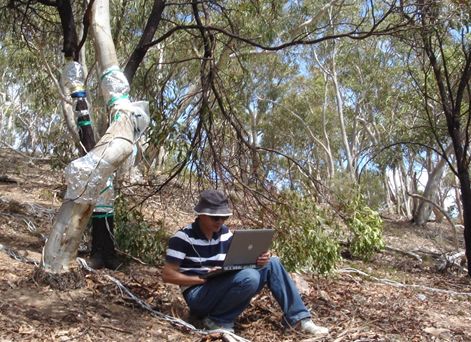To my mind, ecohydrology means the study of interactive processes on land surface that involve both plants and water, their influences on water resources, carbon fluxes, and heat balances, and their responses to environmental changes. As vegetation occurs almost everywhere on the terrestrial surfaces, ecohydrology has broad applications in the management of terrestrial resources and environments, such as water resources, forests, agriculture, and urban environment.
Physical processes that are investigated in ecohydrology form the core of land surface and atmosphere interactions. Thus, ecohydrology is closely associated with, and often difficult to be distinguished from hydrometeorology. My research area covers both ecohydrology and hydrometeorology. We actually have an acronym for my research group -- EcoH2OMe.
Ecohydrology is an interdisciplinary research field. Hydrology and ecophysiology are two obvious important disciplines for ecohydrology. Breadth of knowledge and skills, and cross-discipline research collaborations, are likely more rewarding for ecohydrology than other research fields.
What are your undergraduate and graduate degrees in?
I have an undergraduate degree in geochemistry from Peking University, Master’s degree in groundwater from the University of Texas at El Paso, and PhD degree in mountain hydrology from New Mexico Tech. I am happy with the breadth of training I have received in these degrees. My research in ecohydrology has greatly benefited from this training, as well as other knowledge and skills that I picked up on the way of my research until now.
For students in any field of science, if you don’t know yet what to do, come study ecohydrology.
How did you arrive at working in/thinking about ecohydrology?
My interest in ecohydrology started at New Mexico Tech, where I did my PhD study with Dr John Wilson. I initially applied for a PhD study at New Mexico Tech mainly because of Tech’s groundwater hydrology ranking (the 4th in 2000). But it seemed that groundwater research at Tech was “surfacing” at that time. John started to look at mountain front recharge, which became my PhD study subject. Dr Fred Phillips was investigating vegetation impacts on groundwater recharge. Two young professors at New Mexico Tech then, Dr Eric Small and Dr Enrique Vivoni, were very active in ecohydrology research.
The landscape surrounding Socorro also helped to shape my interest in ecohydrology. I was fascinated by the clear grass-creosote and creosote-juniper boundaries in Sevilleta, although this was not the focus of my PhD study.
The key driver, pushing me away from hydrogeologically investigating mountain front recharge towards using surface-based approaches (including ecohydrology), was the difficulty in obtaining subsurface data. My PhD study ended up with developing methods to quantify the atmospheric boundary conditions (including both precipitation, potential evaporation and transpiration) over complex terrains, and modelling water partitioning on hillslopes. Development of a dual-source surface energy partitioning model in my PhD study at Tech was probably my first ecohydrology-related research.
I started field-based ecohydrology research in 2010, a couple years after I joined Flinders University. My students and I investigated the soil-plant continuum with concurrent measurements of sapflow and stem water potential. We hope to characterize root zone and plant hydraulic properties and states based on both measurements, like observation wells and pumping tests in groundwater hydrology. This concept, which I now call “root zone periscope”, has been applied to test and develop root water uptake and transpiration models. The computer program of a vegetation-focused soil-plant-atmosphere model (vSPAC) is now available upon request.
What do you see as an important emerging area of ecohydrology?
This is a difficult question. Perhaps the recent ecohydrological separation concept, first proposed by Brooks et al. (2010) in Nature Geoscience, could be one emerging area. Dr Fred Phillips made clear and concise comments on the potential significance of this concept from both theoretical and application aspects, including the implications for catchment hydrology, fertilizer application, and soil remediation.
Understanding and modelling the connections between physical processes and plant mechanistic processes in the soil-plant-atmosphere continuum could be another emerging area. Such understanding and modelling capacity are essential to predict vegetation ecosystem responses to changing climates. One example is the recent findings on the impact of the increased atmospheric CO2 concentration on plant stomatal conductance and the consequence on large-scale water balance, published in Nature Climate Change by Dr Yuting Yang and Dr Michael Roderick et al. (2018).
Do you have a favorite ecohydrology paper? Describe/explain.
My favorite ecohydrology paper is McDowell et al. 2018, Mechanisms of plant survival and mortality during drought: why do some plants survive while others succumb to drought? published in New Phytologist. In this paper, the authors proposed a concise conceptual framework to explain the contrasting responses of pinon and juniper in the early 2000s drought in New Mexico. The concept links plant drought response to measurable ecohydrological variables. Based on these measurements, plants can be categorized into isohydric and anisohydric species. An isohydric species is more likely to develop carbon starvation, while an anisohydric species tends to develop hydraulic failure in a drought.
More broadly, I like Kirchner 2009, Catchments as simple dynamical systems: Catchment characterization, rainfall-runoff modeling, and doing hydrology backward, published in Water Resources Research. This paper demonstrates how the catchment water balance components can be resolved based on time series streamflow data only. I find the philosophic support in this paper for my own research approach in ecohydrology – conceptualizing the system in such a way that it can be investigated by easily obtainable data.
What do you do for fun (apart from ecohydrology)?
When I have spare time, I like to walk and listen to music. But I don’t know much about music. A student once found that I kept listening to the same couple of songs for a whole semester!

 RSS Feed
RSS Feed